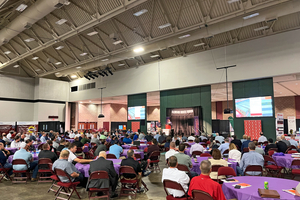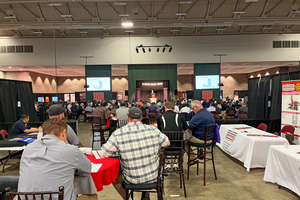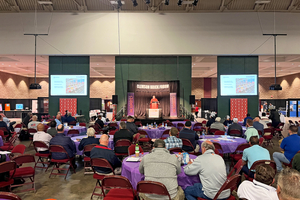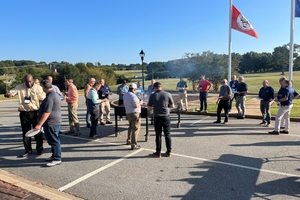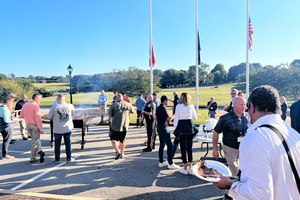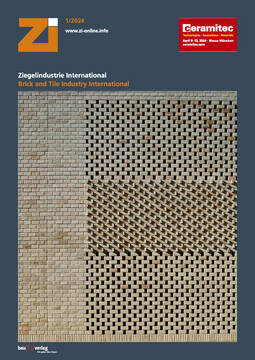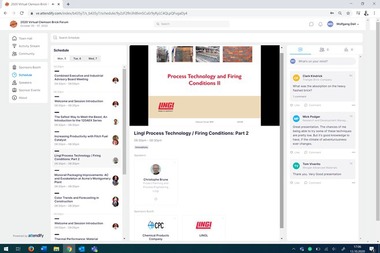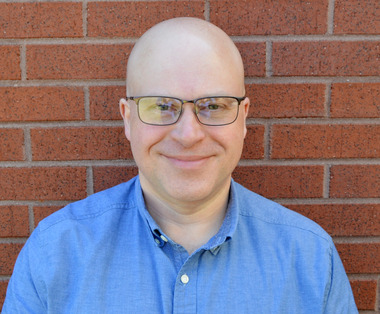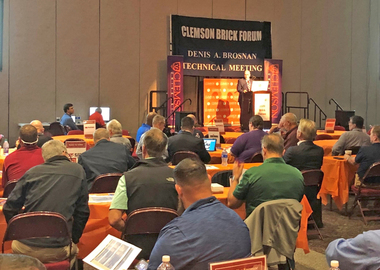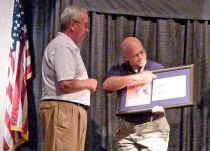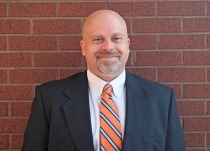The 69th Clemson Brick Forum - meeting place for the US brick industry
Autumn in South Carolina is very beautiful. Warm, almost summer-like temperatures and bright sunshine entice you outside. In contrast, it was cool enough for a jacket in the Civic Centre of Anderson, the venue for the Clemson Brick Forum, thanks to powerful air conditioning systems. The US brick industry met there on 2 and 3 October 2023 for the most important event of the year. The hall was divided into three sections, with suppliers‘ stands at either end and the lecture area in the centre. John Sanders, Director of the National Brick Research Center, which is organising the forum, welcomed the 400 or so participants on the first day.
Presentations and topics
The programme of the Denis A. Brosnan Technical Meeting included more than 40 presentations on both days. Around three quarters of these were given by brick manufacturers. Among the highlights of the first day was the presentation of a new plant opening in Texas by Triangle Brick, the US subsidiary of Röben Baustoffe. According to Sanders, this has not happened for more than ten years. Most of the other presentations by brickmakers focussed on upgrades in existing plants. General Shale presented new kiln controls at the Columbia plant and unloader upgrades at the Roanoke plant. ACME reported on a kiln conversion in one of its plants in Texas, Belden Brick on the upgrade of its Plant 8. One exception was Ricardo Sanchez from General Shale, the US subsidiary of Wienerberger, who presented a particularly interesting approach to automatic quality control. A Keyence Colour Camera is used to take constant pictures of the production process. A programme measures the amount of black pixels on the products, indicators of quality issues. If three consecutive images exceed the limit value, the system is designed to send a signal to shut down the plant and inform the operator where the problem has occurred.
The machine manufacturers and suppliers also sent their experts to the Brick Forum. Domenico Burchi from SACMI, for example, presented the advantages of brick slips as a building material as well as his company‘s suitable production system. Brick slips can be mechanically attached to thermal insulation and are suitable for prefabricated modular construction. For manufacturers, brick slips are more worthwhile than traditional bricks due to their high added value production. Flat extrusion allows a flexible and versatile manufacturing process for complicated geometries. The use of roller dryers and roller kilns allows the production process to be ramped up and down quickly and requires little space. Finally, he also emphasised the resulting easy maintenance of the system.
Frank Appel from Innovatherm presented new combustion technologies for the tunnel kiln that can reduce fuel consumption and CO2 emissions. He used a particularly catchy method to illustrate the savings: he used a Ford F150 as a unit, stating that the example tunnel kiln emits as much CO2 per year as 578 Ford F150s. Innovatherm‘s technology achieves savings of around 20 per cent, which corresponds to 115 of these cars. The technology itself is based on reducing the amount of air to be heated. This is made possible by optimising the control of the burner air. Very short switching times are possible with magnetic valves.
Holger Rottmann and Markus Schweiggart from Lingl presented process technologies for CO2 reduction. These included measures to increase energy efficiency such as the separation of dryer and kiln, the preheating of combustion air, the reduction of exit losses through the kiln cars, or the use of heat pumps to utilise exhaust air heat from dryers. With all the measures presented, an improvement of 38 per cent could be achieved. Individual measures were explained in detail, with process optimisations such as the transfer of exhaust heat back into the kiln offering great potential. They also discussed various fuel applications such as synthesis gas and liquid gas. Lingl is also developing electric kiln and dryer solutions. The main problem with these technologies is the supply of cheap, renewable electricity.
The third group of presenters came from the associations. Ryann Coyle, from the Tile Council of Noth America, discussed the Embodied Carbon Initiative for the Ceramic Tile Industry. For the reduction of embodied carbon, it is important to have standardised EPDs available. Coyle explained the concept of EPDs and emphasised that the tile industry relies on triple transparency with EPDs for the three most important products: tiles, cement mortar and cement slurry. However, there are major differences in the use of EPDs, particularly in the complete recording of environmental impacts over the life cycle of 75 years. This is because some support cradle to grave, others only cradle to gate (production and delivery, without use, repair, replacement and disposal). The problem behind this is that there is currently no binding consensus standard to record embodied carbon. The tile industry is in favour of cradle to grave.
Terry Schimmel, from the Brick Industry Assocation of America (BIA), provided a very interesting insight into the work of the industry association. Workplace safety, for example, is a topical issue. More accidents occur in the brick industry than in the industry as a whole, although the figures are already falling. He also presented how the BIA tries to exert political influence on the government. Topics include low tax rates, appropriate regulations, access to affordable energy and natural gas and access to labour. Labour shortages are a pressing issue.
Entertainment programme and announcement
Programme items were also reserved for networking and physical well-being. The wine tasting on Monday afternoon was organised by Vitreus GmbH. Visitors had the opportunity to visit the exhibitors‘ stands and talk shop over a good drop of wine. The highlight, as every year, was the steak cookout sponsored by J.C. Steele on the second day. While people queued at the meat counter, cooked their steaks on large grills or ate them at the table afterwards, everyone was in a good mood and quickly got talking.
The next edition of the Clemson Brick Forum has been announced for 30 September and 1 October 2024.

